The sombre greenbuls that visit our garden all year round are mostly evident from their loud and penetrating contact calls as they forage while concealed in dense vegetation or high up within the tree canopies.

Due to their dull – or sombre – colouration and their predilection for keeping within cover, sombre greenbuls (Andropadus importunus ) are not easy to see even when they are calling loudly.
However, they do emerge from cover to visit the birdbaths but usually only when they are not obviously observed by humans. I have managed to take some photos of them at the birdbaths by using a makeshift ‘bird hide’ or by sitting very still behind a screen of plants.
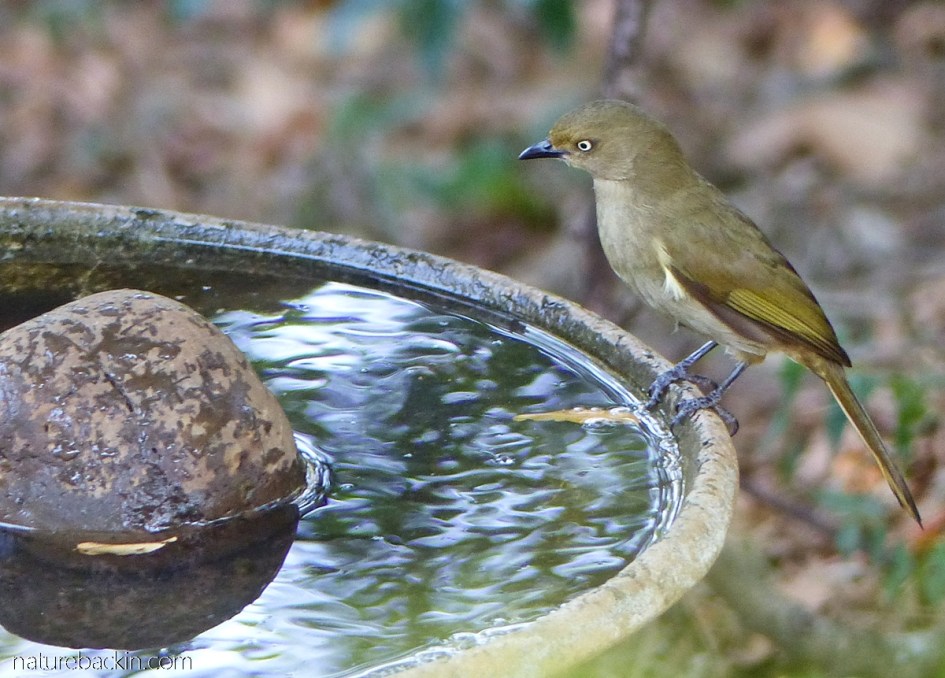
When out in the open sombre greenbuls can be seen to be rather neat in appearance, with their very pale eyes being their most distinguishing feature. Juvenile birds have darker and browner eyes than fully mature adult birds.
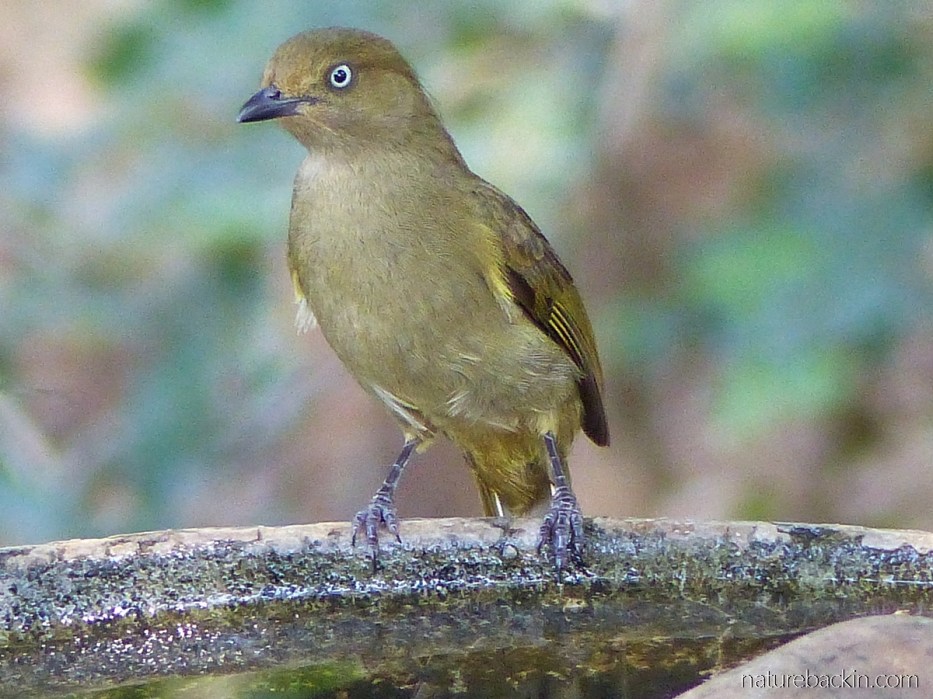
Sombre greenbuls (also known as sombre bulbuls) are handsome birds with olive-green colouration on their backs and wings, with their undersides being slightly greyer. They prefer well-vegetated habitats and occur in natural forests, thickets and dense woodlands, and in some regions they have adapted to gardens in suburbs where there are plenty of trees and suitable vegetation.
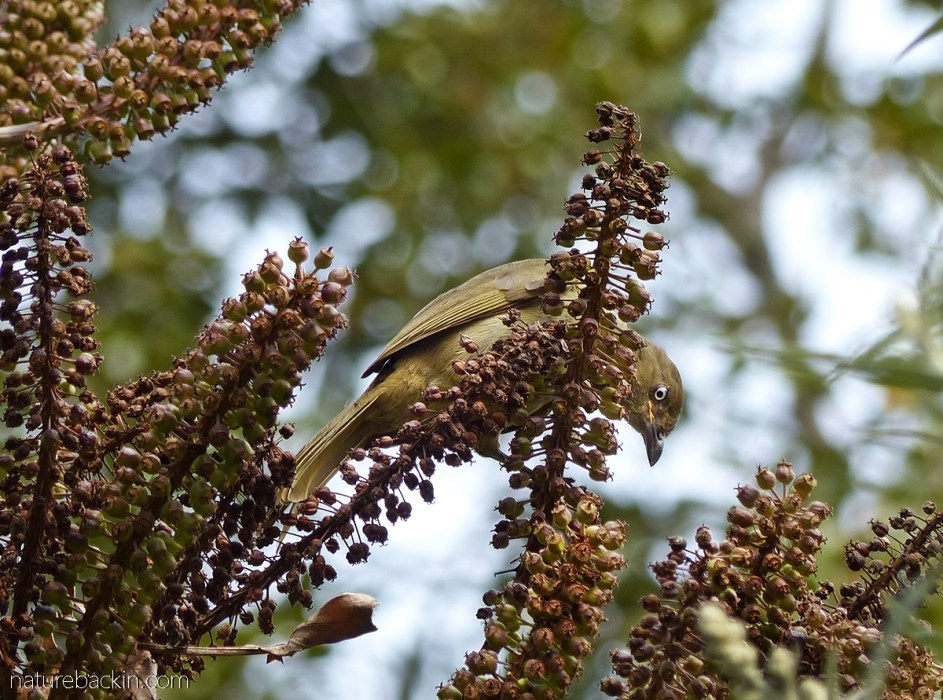
Sombre greenbuls find food by climbing around in trees and shrubs, sometimes coming down to the ground to forage in leaf litter. They also hawk insects on the wing, returning to cover to eat their catch. In the above photo a bird is clambering around the branched fruiting inflorescences of a cabbage tree (Cussonia sp.) in our garden.
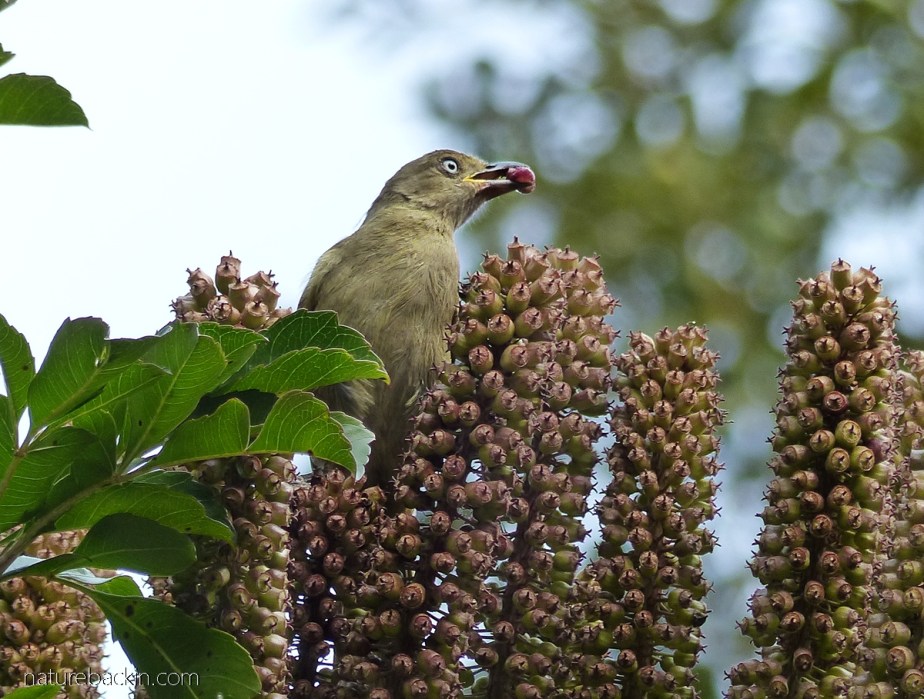
The bird spent quite some time selecting and eating fruit in the cabbage tree. The strong bills of sombre greenbuls are adapted for an omnivorous diet, which includes fruits, flowers and buds, succulent leaves, insects, snails and aloe nectar.
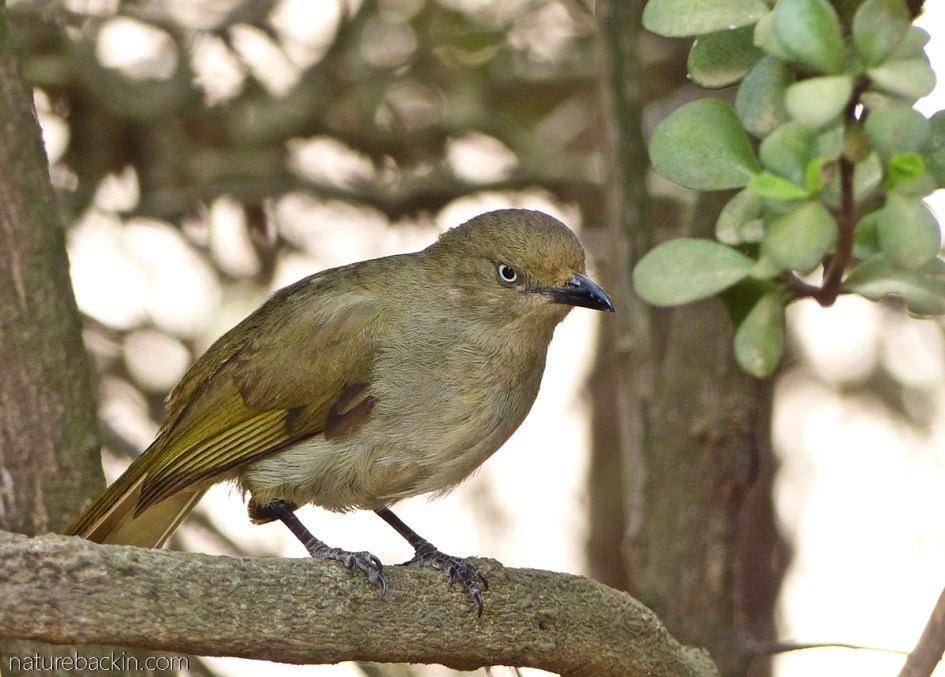
I took the above photo in 2016 when we were staying in the small and densely vegetated Spekbook Tented Rest Camp at the Addo Elephant National Park. In the camp several species of birds have become habituated to people and are fairly tame. This sombre greenbul was perched near to our tent.
The two-syllable ringing contact call of the sombre greenbul, sounding something like ‘willie’, is reflected in its names in isiZulu (iWili), isiXhosa (inkwili) and Afrikaans (gewone willie). For recordings of the contact call and the more jumbled sounds of its song go to https://www.xeno-canto.org/species/Andropadus-importunus.
Also at this link, a distribution map shows that the sombre greenbul is an African species. There are four subspecies occurring mostly down the eastern side of Africa from southern Somalia and Kenya in the north, down to South Africa with distribution extending on down along the inland regions adjacent to the southern coastline.
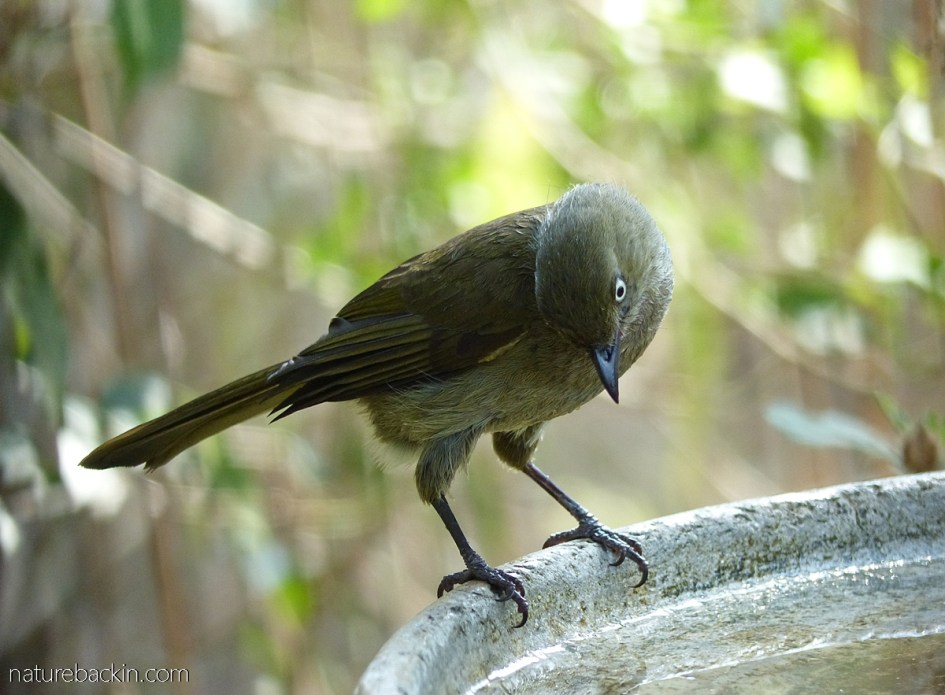
Back at one of the garden birdbaths, this sombre greenbul had just arrived and was busy scrutinizing the bathing spot. Like the dark-capped bulbuls and terrestrial brownbuls that also visit our birdbaths, the sombre greenbuls are enthusiastic and energetic bathers. All three species belong to the Pycnonotidae or Bulbuls family.

After some energetic dunking it doesn’t take long for the normally sleek sombre greenbul to look fluffy and dishevelled. Their style of bathing includes dramatic plunges into the water, rising out immediately in flight then settling down again to preen for a while before plunging in again.

Preening can be almost as energetic as plunging, involving much fluffing and shaking of wing and tail feathers.
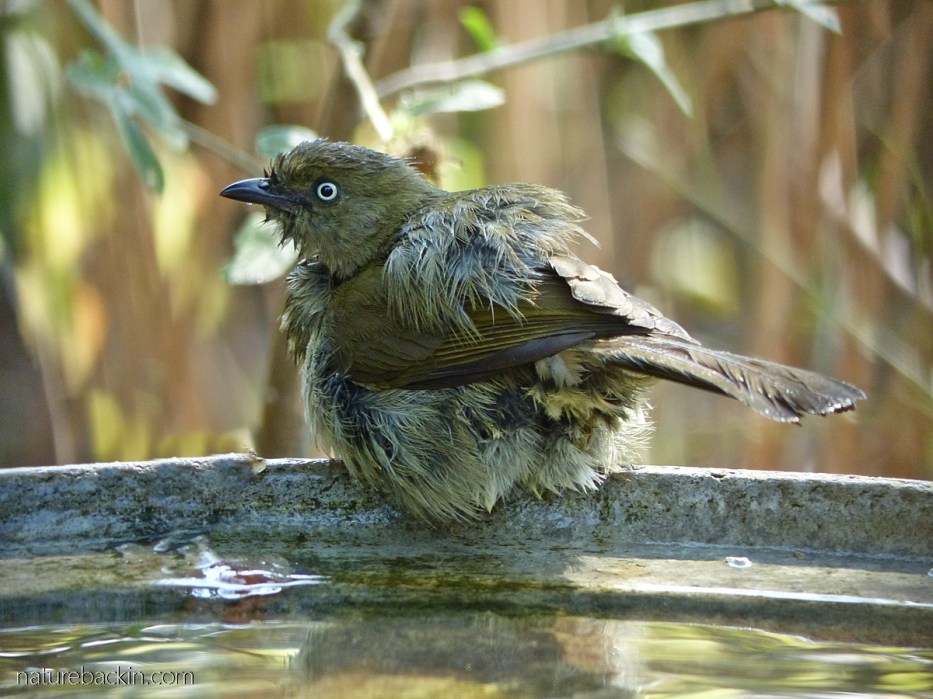
By the end of the bathing session this sombre greenbul was well soaked.
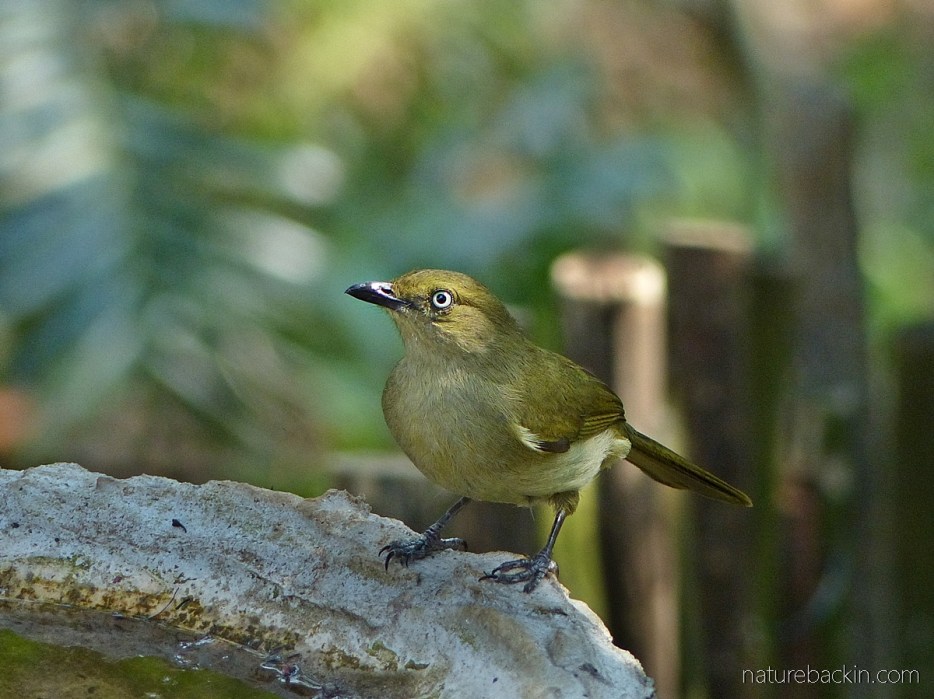
Who would think that such a normally sedate and sombre bird can become so transformed while bathing!
Sombre greenbuls form monogamous pairs. When breeding, only the female incubates the eggs and the male brings her food. Both parents feed and raise the young.
Nests are made from twigs, rootlets, grass, lichen and other plant fibres. The cup-shaped nests are lined with finer grasses, small roots and other fine plant fibres and sometimes hair. The nests are secured to supporting branches or foliage by spider web, and nests are usually situated between 1.5–2.5 metres (5–8 feet) above the ground in slender trees or shrubs.
Bird-friendly gardens are alive with interest and possibilities that well-manicured spaces sadly lack. More natural gardens that include at least some indigenous plants and secret undisturbed corners are attractive to birds and provide potential for shelter, diverse materials for making nests and food too.
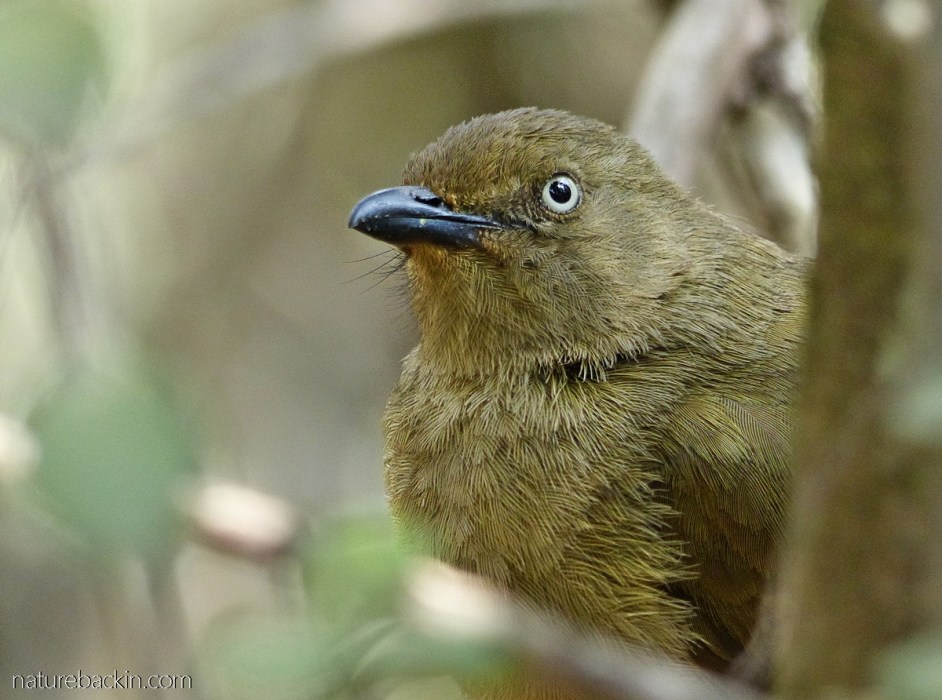
This close-up of a sombre greenbul was also taken at Spekboom camp at Addo. What a pleasure to be surrounded by natural bush and the bustling sounds and calls of birds foraging and going about their business. Such places are inspirational for those of us lucky enough to have gardens. We can learn how to make our gardens more natural and more diverse places one plant at a time.
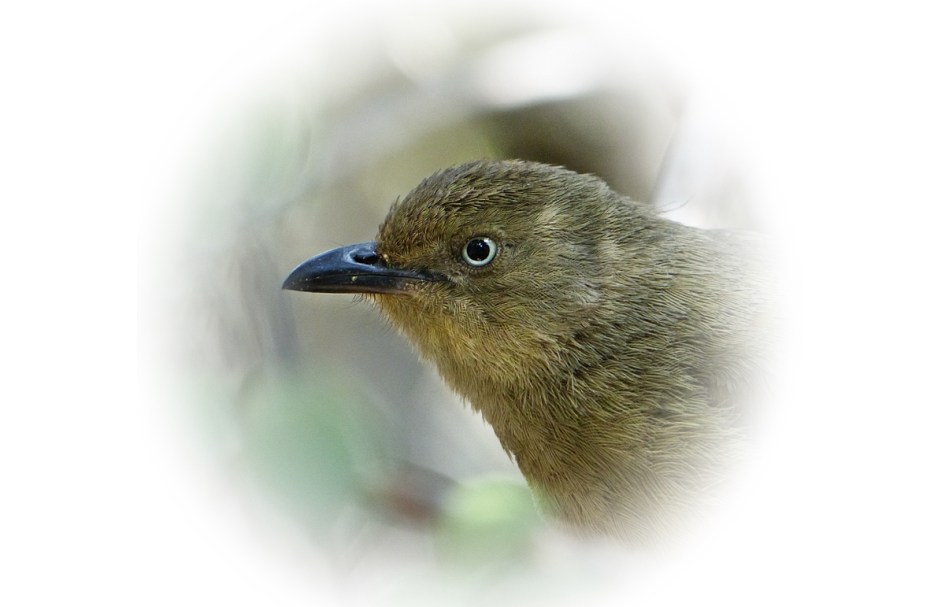
Sources:
Xeno-canto Foundation. 2005-2021. Sombre Greenbul – Andropadus importunus. https://www.xeno-canto.org/species/Andropadus-importunus; Chittenden, Hugh, Davies, Greg & Weiersbye, Ingrid. 2016. Roberts Bird Guide: Illustrating nearly 1,000 Species in Southern Africa (2nd edition). Cape Town: Jacana; Roberts VII Multimedia Birds of Southern Africa: PC Edition. 1997-2016 Southern African Birding. For details go to http://www.sabirding.co.za/roberts7/portal.html
Posted by Carol









June 24, 2021 at 11:58 am
Marvellous photos Carol! You have shown us many colourful species in your posts and here we see that even the more sombre are every bit as fascinating.
LikeLiked by 1 person
June 24, 2021 at 9:26 pm
Thanks Sandra. I agree that sombre can be fascinating too.
LikeLiked by 1 person
June 24, 2021 at 8:04 am
Oh yes, timing is absolutely key.
LikeLiked by 1 person
June 20, 2021 at 6:07 pm
These are stunning pictures! Must have taken you a lot of time and patience to capture them.
LikeLiked by 1 person
June 23, 2021 at 7:13 pm
Thanks very much Saurab. I find it so interesting and almost a meditative process observing nature so it doesn’t feel like time and patience – and of course a lot depends on the luck of being in the right place at the right time when it comes to taking photos of animals and birds …
LikeLiked by 1 person
June 19, 2021 at 2:03 pm
Another delightful and educational post. Beautiful description of the bird’s bathing dance, with wonderful photographs
LikeLiked by 1 person
June 19, 2021 at 7:24 pm
Thanks Mariss – great to share the pics of such an intriguing bird.
LikeLiked by 1 person
June 19, 2021 at 10:44 am
I broke my blog-free-while-in-Spain resolution to read this thoughtful, informative and as usual delightful piece. Thank you!
LikeLiked by 1 person
June 19, 2021 at 7:23 pm
Thanks Margaret – a great compliment!
LikeLiked by 1 person
June 18, 2021 at 1:57 pm
What a joy to be introduced to the sombre greenbul. Your presentation was flawless, Carol, and much enjoyed. Your narrative is relaxing and thorough, the photos are spectacular, and the ways of this delightful bird were beautifully shared. I went to the xeno-canto link and found their tropical sounds to be wonderful. There’s so much exotic here, with cabbage trees and elephant parks, and this curious bird that I was completely unfamiliar with. I loved the sequence of the bathing with your observations and terrific photos, too. Always a delight to be here, Carol, thank you.
LikeLiked by 1 person
June 19, 2021 at 7:17 pm
Thanks very much Jet. The sombre bulbuls are very vocal around the garden currently – I am reframing their call as tropical, which I suppose it is!
I have been thinking I need to do a post on cabbage trees and it is now definitely on my mental list of potential topics.
LikeLiked by 1 person
June 18, 2021 at 10:32 am
I can’t recall seeing these birds in the wild, and I’m sure I would have noticed their striking eyes. It was very interesting to learn all about them, and your photos of them are lovely. Thank you for another interesting post!
LikeLiked by 1 person
June 18, 2021 at 8:47 pm
Thanks Megan. They can be difficult to see even when they are very audible. I was happy to have photos to share as they are such interesting birds.
LikeLiked by 1 person
June 18, 2021 at 9:17 am
These are wonderful images, Carol. I always enjoy watching the birds in the bird bath having so much fun, and you have captured these wonderfully here! 🙂 Makes me smile, thank you 🙂
LikeLiked by 1 person
June 18, 2021 at 8:45 pm
Thanks Pete – nice to hear from you. The birds really do seem to have fun while bathing. It is nice to share in their enjoyment 🙂
LikeLiked by 1 person
June 18, 2021 at 7:35 am
they have nested in a shrub (mind has gone blank on the name of it) next to the carport on your side of our old house.
LikeLiked by 1 person
June 18, 2021 at 8:44 pm
Oh thanks John. I will skulk around there and keep and eye open to see if perhaps they still nest there. I was there this morning and was most happy to see a batis, by the way.
LikeLike
June 18, 2021 at 6:45 am
Great portrait with beautiful pictures of the Sombre Greenbuls! The eyes of the birds are really extraordinary.
LikeLiked by 1 person
June 18, 2021 at 8:41 pm
Thanks Simone. Their eyes are very striking and give them a most penetrating stare.
LikeLiked by 1 person
June 18, 2021 at 5:05 am
You have made my day! ‘Our’ sombre greenbuls have been fairly quiet recently, although I still see one or two from time to time – usually peeping out of the greenery. Addo is the best place I have found for photographing them for they do not approach me near enough – or clearly enough – in the garden. I am delighted that you have focused on these interesting birds and marvel at your photographs of those bathing.
LikeLiked by 1 person
June 18, 2021 at 8:40 pm
Thanks Anne. There is a lot of bird activity in our garden currently – the birdbaths are very busy in the late morning and a pair of sombre bulbuls join in and are quite vocal while in the surrounding vegetation. Even though they are here regularly it is difficult to get a clear photo of them as they tend to keep within the foliage, but they are easier to see than the southern boubous who are also around. I also found that both species were easier to see at Addo.
LikeLiked by 1 person
June 18, 2021 at 3:12 am
Marvelous photographs, Carol!
I had great fun with a pair of sombre greenbuls when we visited Bontebok National Park in December. I was walking along the Bushbuck Trail along the river, and was followed all the way by a pair of Willies. They kept well hidden for the most part when I tried to get their pictures, but when I had my back turned to them they would come quite close – they seemed very curious!
LikeLiked by 1 person
June 18, 2021 at 8:35 pm
Thanks Dries. How interesting to be tracked by a pair Willies. Too bad they were camera shy though!
LikeLiked by 1 person
June 18, 2021 at 1:46 am
I love their eyes. Very expressive!
LikeLiked by 1 person
June 18, 2021 at 8:33 pm
Yes, their eyes really do give them an intense look.
LikeLiked by 1 person
June 18, 2021 at 1:36 am
Beautiful birds! Their habits remind me of our catbirds, who “talk” a lot, and follow me around whenever I am gardening, but all from the nearby bushes or other cover spots. Like the greenbuls, though, just get them near the bird baths in the yard, and they become totally different-natured. I love to hear their “commentary” on my work as I do my garden chores. Love all your helpful links, by the way!
LikeLiked by 1 person
June 18, 2021 at 8:32 pm
I just looked up catbirds and found gray catbirds – is that the species in your garden? I heard a recording of their catlike call. They sound like great companions in the garden and interesting that they also lose their shyness once in the birdbath.
Its nice to know the links are useful, thanks.
LikeLike
June 19, 2021 at 1:36 am
Yes, it is the gray catbird. They have their “cat” sound, (I would say a crabby cat!), and then they will go off on other repeated sounds. A couple years back, a catbird was around for the Summer who was not shy, and would repeat sounds that we called to it. We named him Cat Stevens, as he was such a good singer. The birds now must be the children of Cat Stevens, but , alas, they are not as melodious. Birds certainly have their individual personalities!
LikeLiked by 1 person
June 19, 2021 at 7:21 pm
Naming your singing catbird Cat Stevens is priceless 🙂
We had a chorister robin here who copied the way we whistled for our then dogs. Sometimes at dusk I would have a kind of a call and response duet with the robin 🙂
LikeLiked by 1 person
June 18, 2021 at 1:22 am
I loved learning about your handsome sombre greenbuls, and your photos are excellent, Carol. The bathing ones are esp. delightful!
LikeLiked by 1 person
June 18, 2021 at 8:25 pm
Thanks Eliza. They do seem to genuinely enjoy their bathing times.
LikeLike
June 17, 2021 at 9:24 pm
Hello Carol,
I love their stunning eyes and how you captured their expressions! Seeing them in their natural environment gives another glimpse into your beautiful country 🙂 I may have not been commenting as much, but I always enjoy your posts. Hope you and all your dear ones continue to stay well.
Best wishes,
Takami
LikeLiked by 1 person
June 18, 2021 at 8:22 pm
Hi Takami
Lovely to hear from you and thanks. The pale eyes of the sombre greenbuls really do add to their intensity.
We are doing okay thanks. Sadly, a third wave of Covid-19 infections is currently surging in SA. Vaccine rollout is slow so I am fortunate to have had my first jab.
I hope that you and your family keep safe and best wishes to you too.
LikeLiked by 1 person
June 22, 2021 at 5:05 am
That is great news to hear you have received your first vaccination! Hoping you receive your second one soon, and that you stay safe despite the third wave. Our best wishes to you always.
LikeLiked by 1 person
June 23, 2021 at 7:26 pm
Thanks Takami. I think the infection rate in Japan is currently much reduced? Which must be a huge relief. Of course most of the more prominent news about Japan that we are seeing at the moment is related to the Olympics.
With best wishes to you too and keep safe.
LikeLiked by 1 person
June 24, 2021 at 12:38 pm
Thank you Carol. Unfortunately, while the number of new infections have gone down, cases are rising again. And unfortunately, most of our population still have not received the vaccinations… So we continue to take it a day at a time, and do our best to keep healthy. Thank you again 🙂
LikeLiked by 1 person
June 24, 2021 at 9:28 pm
So sorry to hear the cases are rising again. As you say we can only do our best to keep safe.
LikeLiked by 1 person